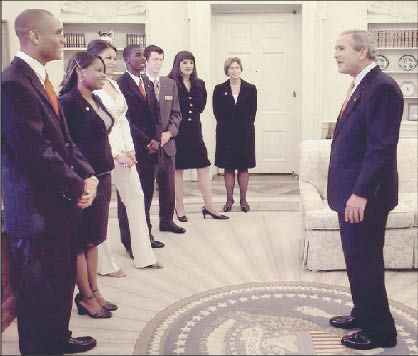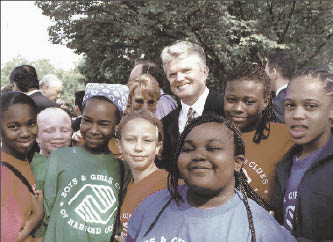But that’s down from its peak of $85 million in fiscal 2006. Last fiscal year, which ended Sept. 30, the group that claims over 4.8 million youth served through 4,100 clubs received $70 million from the Justice Department’s Office of Justice Programs (OJP). Of next year’s anticipated $60 million, $30 million will probably be awarded to a separate group, FirstPic Inc. The for-profit consulting firm is based in Crofton, Md., and run by Mark Piccirilli.
That’s no small matter for the BGCA headquarters in Atlanta and it’s national staff of 350. Government revenue made up just over 50 percent of its 2006 total revenue of $166,768,897. Some observers are pointing to the leadership style and staffing decisions of BGCA President Roxanne Spillett for the group’s setbacks.
 |
|
Talking the talk: President Bush meets with the 2006 finalists for BGCA’s Youth of the Year. Joining the youths are BGCA President Roxanne Spillett (second from right) and Lorraine Howerton, who was then vice president of government relations (right). |
Others, including Sen. Patrick Leahy (D-Vt.), chair of the Senate Judiciary Committee, which oversees OJP and its Office of Juvenile Justice and Delinquency Prevention (OJJDP), hold Spillett harmless. Leahy told Nose Knows the BGCA problem is the White House, which zeroed out BGCA in its budget proposal for fiscal 2008, as it has done in previous years. For the White House, says Leahy, having the president meet with the BGCA’s National Youth of the Year is “a great photo opportunity.”
He snaps, “It’s about time they [the White House] started walking the walk, not just talking the talk.”
By most accounts, there’s plenty of blame to go around for what appears to be a looming forfeiture of BGCA’s constant bragging about opening a new club every day. In 2006, BGCA revenue dropped by $7 million over the year before, while expenses climbed by another $7 million.
The Robbie Factor
Since 1983, direct congressionally ordered funding of BGCA has been crucial to its robust growth. At the BGCA annual congressional breakfast on Sept. 19, board chairman Rick Goings told an overflow audience of 400 that federal funding “made all the difference” in BGCA’s rapid growth.
 |
|
Robbie Callaway with the beneficiaries of his lobbying talent. |
In 1983, BGCA received $55,000 from OJJDP. Until then, the job of BGCA’s solo Washington representative was to get the boss invited to the right events at the White House and on Capitol Hill, with an emphasis on public relations. The late Tom Garth, soon to become BGCA’s chief executive, was determined to change all that. In 1982 he hired Robbie Callaway, an experienced youth worker and Washington youth policy operative, to vigorously shake the federal money tree.
Callaway’s efforts, aided greatly by the boom in non-competitive earmarking by Congress, succeeded beyond anyone’s expectations. Over the next 23 years, more than $600 million flowed directly to BGCA’s Atlanta headquarters, with about $100 million more in earmarks going directly to BGCA affiliates, which today number 1,168 and operate those 4,100 clubs.
Concurrently, Callaway was putting his previous experience in organizing statewide coalitions of community-based youth service agencies to productive use. Aided by Kevin McCartney, a former BGCA executive director in Tracy and Sacramento, Calif., BGCA set up Boys & Girls Club Alliances in 45 states, plus Indian Country. These 501(c)4s are different from the 501(c)3s typical of direct-service youth agencies. They can lobby state legislatures and Congress without limit, but donors receive no tax deductions.
This year, those BGCA alliances expect to steer about $70 million in state Temporary Assistance to Need Families, 21st Century Community Learning Center and other funds allocated by state government to local clubs. This year in California alone, the state alliance, led by McCartney, expects to win up to $20 million in Proposition 49 after-school funds for the state’s 145 organizations, which run 450 sites.
By the time Callaway departed from BGCA in late 2005 after 23 years, Nose Knows dubbed him the Billion Dollar Youth Worker.
Since 2001, Callaway has had to fend off attempts by the Bush administration to zero out BGCA funding. He turned one ill-fated White House threat to eliminate funding into opportunity. He lobbied an upgrade for BGCA from a mere earmark into its very own line item in the OJP budget – the equivalent of an unassisted triple play in the contact sport of lobbying. As one veteran big city club director says, the web of influence – from picking FirstPic to helping fund new clubs and orchestrating the political art of allocating federal funds not claimed to support the national BGCA office – “all goes back to Callaway.”
The No Robbie Factor
When Callaway announced his departure in 2005, expectations were that his well-groomed deputy, Steve Salem, would take the reigns to retain public funding at the federal and state levels. Hire Salem and get Callaway for free. Why not? But BGCA President Spillett had long chafed over Callaway’s prominent profile and independent ways. The BGCA’s annual Capitol Hill breakfast and visits to the White House had presidents and members of Congress publicly singing Callaway’s praises. Even the late Strom Thurmond (R-S.C.), who could barely remember his own name by his 100th birthday, could appreciatively utter “Robbie” five times in a two-minute speech.
Spillett, who was not willing to be interviewed for this column, declined to tap Salem for the job. Instead, she undertook a national search. At a December 2005 board of governors meeting shortly after Callaway’s announced departure, Salem gave a realistic report on future federal funding prospects. He was promptly informed by Spillett that a national search would be conducted to fill his job and he could apply to be a candidate. Salem immediately went to work for the Cal Ripken Sr. Foundation. No Salem, no Callaway.
Oddly, it was a no-youth-worker-need-apply search. Hired to replace Callaway was Lorraine Howerton. In May 2006, Youth Today pronounced her “strong on lobbying and lean on youth work.” Howerton’s job wasn’t made any easier when Spillett abolished the 15-member BGCA government relations committee soon after Callaway left his post. It was made up of veteran affiliate managers carefully picked by Callaway to work with key home state members of Congress serving on important appropriations committees. During the next 16 months, operating from the far reaches of D.C.’s suburbs, she proved to be lean on lobbying and invisible in youth work. Says one colleague, “Lorraine had no passion” for youth work or the BGCA. Big surprise that. Said another BGCA veteran, “If I never see Lorraine again, it will be too soon.”
Out of the loop per Spillett’s instructions were Callaway, now happily running a biotech company, Technology Investors Inc., and Salem, now at the Ripken Foundation in Baltimore, which funds baseball and other sports programs, mostly through BGCA affiliates.
The results (or lack thereof) soon began to squeeze the BGCA. Government grants in 2006 – the fruits of Callaway and Salem’s labors in 2005 – totaled $83,839,472, half of the national office’s total revenue. Wouldn’t that $84 million surprise former president Herbert Hoover, chair of what was then the Boys’ Clubs of America from 1936 until his death in 1964. He’d be even more surprised to learn that the sum is equal to less than three hours of the $720 million-per day projected cost for the Iraq war.
In February, President George W. Bush again asked Congress to give not a cent to BGCA. The House Appropriations Subcommittee on Science, State, Justice, Commerce and Related Agencies, chaired by earmark-tainted Rep. Alan Mollohan (D-W.Va.), penciled in zero as well. In May, Howerton was forced out.
Robbing Pedro to Pay Roxanne
Driving the downward slide were a convergence of factors: the usual budget crunch exacerbated by the 2007 earmark moratorium, the absence of Callaway, and – most potently – growing concerns on Capitol Hill and at OJP over the BGCA performance and its high national overhead. Still, at the BGCA Capitol Hill event, Sen. Ted Stevens (R-Alaska), who never met an earmark he didn’t love, declared that the group “gets the biggest bang for the buck.”
BGCA’s federal tax returns tell a different story. In 2003, government revenue totaled almost $77 million, but just over $55 million went to local clubs. Including non-governmental funds, the headquarters passed along some $65 million, not all to its affiliates. For example, the Alexandria-based National Center for Missing and Exploited Children (NCMEC) received $926,406 that year. Callaway is a long-time board member and former chair of NCMEC. The kids of soldiers at Fort Drum Youth Services – home of the 10th Mountain Division, now deployed in Iraq and Afghanistan – received $25.
In 2005, out of total revenues of $187 million, some $75 million came from government. About $56 million went to BGCA affiliates and a few others, including $500,000 to NCMEC.
In 2006, direct public support dropped to $54.3 million, from $90.4 million the year before.
Surely, it was no time to clash with OJP, which, during Callaway’s tenure, held the lightest of reigns guiding BGCA’s decisions on how to spend taxpayer’s money. But under pressure from Capitol Hill appropriators, OJP could no longer ignore the $19 million in 2005 and $15 million in 2006 that was evaporating somewhere within the Atlanta headquarters.
One place it was going was in salaries to senior staff. In 2005, Spillett’s total compensation was $878,567. In 2006 it was $972,908. In 2007, her annual salary is scheduled to cross the million-dollar mark.
Other senior staffers were doing nicely as well. In 2000, Glenn Permuy, a former executive of Boys & Girls Clubs of Tampa, drew $235,077. Callaway that year didn’t make the top five in pay. But in 2003 he earned $352,218, more than Permuy’s $346,994. In 2005, Callaway’s last year on the job, he earned $401,890.
In fiscal 2007, then-Assistant Attorney General Regina Schofield found herself with enormous flexibility, as a virtually pork-free Congress ordered no carve-out for the BGCA, as it had in recent years. In a series of meetings, Spillett conferred with Schofield and her deputy, Cybele Daley, about dealing with growing concerns, which included poor record-keeping and dubious time sheets kept by the national headquarters. Schofield pushed for greater emphasis on the most disadvantaged kids, especially in public housing and in Indian Country.
Spillett came off as arrogant, says one participant. Daley, who as of Oct. 1 is the acting head of OJP, says it was all quite civil, just a professional disagreement. The bottom line, says Daley, is that “very little [of OJP’s funds] would go to administration” of BGCA’s headquarters.
Callaway’s style was plenty of bravado on the political stage, plenty of deference in private. Says one observer, “Behind closed doors he’d be down on his knees, begging for money” for BGCA. Not so Spillett, mistaking the drama of public political theater for the necessity of private accommodation. Adding insult to injury, Spillett bad-mouthed Callaway to the DOJ officials, both among his biggest fans. Says Daley, “Robbie is loved and respected in Washington, D.C.”
 |
|
Mark Piccirilli |
Soon the wreckage was strewn up and down Pennsylvania Avenue. FirstPic, by all accounts that rarest of Beltway creatures – an honest, competent government contractor – morphed from a contractor working through BGCA to open clubs in public housing and in Indian Country to the designated recipient of up to half of BGCA’s shrinking allocations. (FirstPic is also an on-and-off employer of Callaway’s wife, Sue Callaway.) Permuy, BGCA senior vice president of program services, calls FirstPic’s Piccirilli a devoted rainmaker “working constantly to aid Indian kids” on and off reservations.
Along with the $30 million to FirstPic in fiscal 2008 goes the overhead. Piccirilli says FirstPic’s overhead is no more than 5 percent, with the rest going directly to BGCA-affiliated youth clubs.
Return of the Robbie
The Capitol Hill breakfast last month was, as always, a celebratory event. On the surface, its purpose was to commend the five finalists for BGCA Youth of the Year. Some were also cheering the reappearance of Callaway and Salem, each conspicuously absent from last year’s event.
Under intense pressure from OJP and several BGCA board members, Spillett had agreed to bring Callaway and Salem back as part-time consultants to roam Capitol Hill at will. An emerging team of McCartney from California, Permuy from the Atlanta headquarters – both to staff the Washington office – along with Callaway, Salem, Cooney and Piccirilli will try to win back BGCA support at (they hope) $90 million in fiscal 2009.
At the breakfast, Spillett sat stiffly in the front. Callaway and Salem sat at the next table, where members of Congress introducing finalists or just doing drop-ins could schmooze. When Leahy arrived, he sat next to Callaway. No sooner had he vacated the chair than Sen. Ben Nelson (D-Neb.) took over the seat, and also whispered in Callaway’s ear. An exalted Sen. Orrin Hatch (R-Utah) told the audience, “Robbie Callaway is back. We’re happy to see that.” Also sitting at Callaway’s table: Schofield – as of September out of OJP and in at the Washington D.C. office of Seattle-based Casey Family Programs – and Daley.
Now the rebuilding will begin in earnest. BGCA has assets of $283 million – chicken feed for an Ivy League university, but a staggering fortune for a national youth-serving organization. That’s up from $157.5 million in 2003. Some $134 million is in an endowment that grew by $21,708,042 in 2006. Growing an endowment is not without benefit, but local club directors bitterly complain of dilapidated clubs, without functioning sprinkler systems or handicapped-accessible toilets, unable to move past miserable pay scales for full and part-time youth workers.
Without drawing heavily on its endowment, cutbacks on BGCA national staff seem inevitable. Also in the near future: an end to the new-club-a-day mantra.
Spillett’s grip on her job also is slipping – perhaps that’s why she received $412,355 in employee benefits in fiscal 2006. Retirement for a veteran of 29 years in BGCA jobs seems in the offing. After dozens of on- and off-the-record interviews with stakeholders on Capitol Hill and in the Justice Department, and with current and former BGCA national and local club leaders, one thing comes through as crisply as a fall day: They love the BGCA, warts and all. If and when the nation turns its attention to children first, BGCA will be a major beneficiary and service provider. Ten thousand clubs, 10 million kids served? It’s very possible, but not on Spillett’s watch.
Contact: BGCA (404) 487-5700, http://www.bgca.com; BGCA Office of Government Relations (202) 478-6200; U.S. Department of Justice Office of Justice Programs (202) 307-0627, http://www.ojp.usdoj.gov.






























